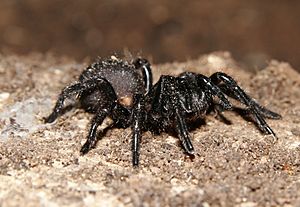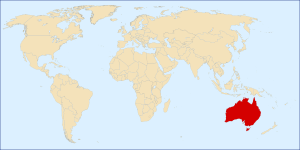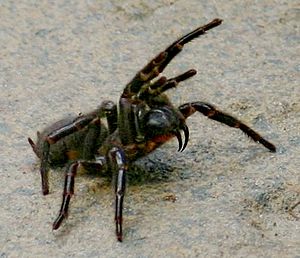Australian funnel-web spider facts for kids
Quick facts for kids Australian funnel-web spider |
|
|---|---|
 |
|
| A Victorian funnel-web spider (Hadronyche modesta) | |
| Scientific classification |
|
| Kingdom: | Animalia |
| Phylum: | Arthropoda |
| Subphylum: | Chelicerata |
| Class: | Arachnida |
| Order: | Araneae |
| Infraorder: | Mygalomorphae |
| Clade: | Avicularioidea |
| Family: | Atracidae Hogg, 1901 |
| Genera | |
|
|
| Diversity | |
| 3 genera, 35 species | |
 |
|
Atracidae is a family of mygalomorph spiders. They are often called Australian funnel-web spiders or atracids. These spiders are found only in Australia. There are three main groups, or genera, of these spiders: Atrax, Hadronyche, and Illawarra. Together, they include 35 different species.
Some funnel-web spiders have venom that can be dangerous to humans. Bites from six of these species have caused serious harm. The bite of the Sydney funnel-web spider (Atrax robustus) and the northern tree-dwelling funnel-web spider (Hadronyche formidabilis) can be deadly. However, no one has died from a funnel-web spider bite since modern first aid and antivenom became available.
Contents
What Do Funnel-Web Spiders Look Like?
Funnel-web spiders are medium to large in size. Their bodies can be from 1 to 5 cm (0.4 to 2.0 in) long. The front part of their body is covered by a smooth, hairless shell called a carapace. Some, like the Sydney funnel-web spider, have long spinnerets. These are small organs at the end of their body that spin silk.
Male funnel-web spiders have a special spur, or spike, on their second pair of legs. This spur helps them during mating. Like other Mygalomorphae spiders, such as tarantulas, their fangs point straight down. They do not point towards each other like in some other spiders. Their venom glands are large and sit inside their chelicerae (mouthparts). Their fangs are strong enough to go through fingernails or soft shoes.
Where Do Funnel-Web Spiders Live?
Australian funnel-web spiders build their homes in places that are moist, cool, and sheltered. You can find them under rocks, inside or under rotting logs, and sometimes in trees with rough bark. They are often seen in gardens, especially in rockeries and shrubberies. They are rarely found in open areas like lawns.
A funnel-web spider's burrow usually has silk lines spreading out from its entrance. These lines act like tripwires. Unlike some related trapdoor spiders, funnel-web spiders do not build lids for their burrows.
Where Are Funnel-Web Spiders Found?
Australian funnel-web spiders mostly live along the eastern coast of Australia. They have been found in New South Wales, South Australia, Victoria, Tasmania, and Queensland. The only parts of Australia where they are not found are Western Australia and the Northern Territory.
How Are Funnel-Web Spiders Classified?
The first funnel-web spider, Hadronyche cerberea, was described in 1873. Another species, A. robustus, was described four years later. For a long time, scientists were confused about how to group these spiders.
In 1901, Henry Roughton Hogg suggested that these spiders were special enough to be in their own group, which he called "Atraceae." This name is the basis for the modern family name, Atracidae. In 2018, scientists officially recognized Atracidae as its own family.
Genera
As of April 2019, the World Spider Catalog lists these groups (genera) of funnel-web spiders:
- Atrax O. Pickard-Cambridge, 1877 — Found in Australia
- Hadronyche L. Koch, 1873 — Found in Australia
- Illawarra Gray, 2010 — Found in Australia
Are Funnel-Web Spiders Dangerous?
Australian funnel-web spiders are considered one of the most dangerous spider groups in the world. This is because of how toxic their venom is and how many people have been seriously hurt by them. Six species have caused severe injuries:
- The Sydney funnel-web spider (Atrax robustus)
- The northern tree-dwelling funnel-web spider (H. formidabilis)
- The southern tree-dwelling funnel-web spider (H. cerberea)
- The Blue Mountains funnel-web spider (H. versuta)
- The Darling Downs funnel-web spider (H. infensa)
- The Port Macquarie funnel-web spider (H. macquariensis)
Most serious bites to humans come from male spiders. Adult males wander around during warmer months looking for females to mate with. They are often attracted to water, so they sometimes fall into swimming pools. These spiders can survive in water for several hours and can still bite when taken out. They are also found in garages and yards in suburban areas. It's important to know that funnel-web spiders cannot jump, but they can run very fast.
When these spiders bite, they usually inject venom. About 10 to 25% of bites cause serious effects. You cannot tell if a bite will be serious, so all bites should be treated as if they could be life-threatening.
Bites from Sydney funnel-web spiders have caused 13 recorded deaths, with seven of these being children. In all cases where the spider's sex was known, it was a male.
What Are Funnel-Web Spider Toxins?
The venom of Atrax and Hadronyche spiders contains many different toxins. These are called atracotoxins (ACTX) because the spiders belong to the Atracidae family. These toxins make nerves fire too much, leading to a release of chemicals that affect the body.
Even though the venom is very harmful to humans, it seems to be harmless to many other animals. This might be because these animals have special substances in their blood that can stop the toxins from working.
It was once thought that female venom was much less strong than male venom. However, a bite from a female or young spider can still be serious. The strength of venom can vary a lot between different species.
What Are the Symptoms of a Bite?
A bite from a funnel-web spider is usually very painful at first because of their large fangs. You might see puncture marks and some bleeding. If a lot of venom is injected, symptoms usually start within minutes and get worse quickly.
Early signs of a serious bite include:
- goose bumps
- sweating
- tingling around the mouth and tongue
- muscle twitching (starting in the face)
- Saliva and watery eyes
- Fast heart rate
- High blood pressure
As the bite gets worse, symptoms can include:
- nausea and vomiting
- Shortness of breath
- Feeling agitated or confused
- Muscle spasms
- Fluid in the lungs (pulmonary oedema)
- Very high blood pressure
In the most serious stages, symptoms include:
- Pupils that are wide open
- Uncontrolled muscle twitching
- Loss of consciousness
- Increased pressure in the brain
Death can happen from very low blood pressure or swelling in the brain. Serious symptoms can appear quickly, sometimes within 28 minutes. Death can occur in as little as 15 minutes for a small child, or up to three days.
How Are Bites Treated?
Because the symptoms are so serious and happen so fast, any bite from a large, dark spider in areas where funnel-web spiders live should be treated as a funnel-web bite.
The first thing to do for a suspected funnel-web spider bite is to apply a pressure immobilization bandage. This means wrapping the bitten limb tightly with a crepe bandage and using a splint to keep the limb still. This method was first used for snakebites. It helps slow down the venom's movement in the body.
More medical care might be needed, but the most important treatment is antivenom. The antivenom is made using venom from the male Sydney funnel-web spider. It works against the venom of all funnel-web spider species. It has also been shown to work against the venom of the eastern mouse spider.
Before antivenom was available, funnel-web spider bites often led to serious illness and death. The antivenom was developed in 1981 by a team led by Dr. Struan Sutherland in Melbourne, Australia. The antivenom works quickly and is very effective. Before antivenom, people with serious bites stayed in the hospital for about 14 days. Now, patients treated with antivenom often go home within one to three days. No deaths have been recorded since the antivenom became available.


